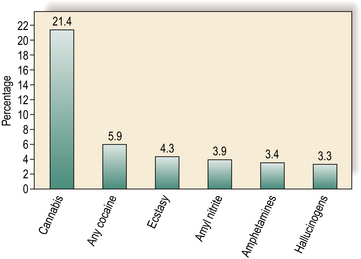Chapter 40 Illegal drug use
illegal drug use has become common, particularly amongst younger people, and this has created extensive concern. The UK has one of the highest drug-use prevalence rates in the world, with perhaps 300 000 problematic drug users and more than 11 million people who have ever used an illegal drug. Figure 1 shows the most widely used types of drug in the UK in 2006. Some forms of drug use, such as cannabis smoking, which is as common as tobacco smoking amongst younger people, are ceasing to be unusual or deviant in the UK, and many illegal drug users, particularly the more moderate ones, probably suffer few problems, just like many alcohol drinkers. This is no reason for complacency, for as prevalence has increased, drug-related problems have increased and diversified. Whereas 20 years ago drug services mostly saw heroin or cocaine users, these days people who seek help for drug-related problems commonly include people whose primary problems are one (or more) of the following:
 Cannabis abuse or dependence (Box 1), usually with alcohol and occasional use of other drugs. Because cannabis is the most prevalent illegal substance, there are more people dependent on cannabis than on all other drugs combined (Dennis et al., 2002).
Cannabis abuse or dependence (Box 1), usually with alcohol and occasional use of other drugs. Because cannabis is the most prevalent illegal substance, there are more people dependent on cannabis than on all other drugs combined (Dennis et al., 2002). Heroin or opiate abuse or dependence, sometimes combined with benzodiazepines and other drugs, and typically involving drug injection (Neale, 2002).
Heroin or opiate abuse or dependence, sometimes combined with benzodiazepines and other drugs, and typically involving drug injection (Neale, 2002). Cocaine or crack cocaine abuse or dependence. The likelihood and severity of cocaine dependence have sometimes been overstated (Ditton & Hammersley, 1996). Yet cocaine is becoming even more prevalent, which will lead to more widespread problems.
Cocaine or crack cocaine abuse or dependence. The likelihood and severity of cocaine dependence have sometimes been overstated (Ditton & Hammersley, 1996). Yet cocaine is becoming even more prevalent, which will lead to more widespread problems. Psychotic or delusional symptoms related to drug use. This is more likely for people with pre-existing mental disorders and is most commonly found with amphetamines or cocaine (Farrell et al., 2002), although it can also occur with cannabis or hallucinogens such as LSD (Abraham & Aldridge, 1993). People already vulnerable to schizophrenia may have symptoms triggered or worsened by illicit drugs, most commonly cannabis (Moore et al., 2007).
Psychotic or delusional symptoms related to drug use. This is more likely for people with pre-existing mental disorders and is most commonly found with amphetamines or cocaine (Farrell et al., 2002), although it can also occur with cannabis or hallucinogens such as LSD (Abraham & Aldridge, 1993). People already vulnerable to schizophrenia may have symptoms triggered or worsened by illicit drugs, most commonly cannabis (Moore et al., 2007). Ecstasy-related deaths are not overdoses but have a different aetiology, which is not yet entirely clear, though it includes hyperthermia (overheating) (Burgess et al., 2000).
Ecstasy-related deaths are not overdoses but have a different aetiology, which is not yet entirely clear, though it includes hyperthermia (overheating) (Burgess et al., 2000).Box 1 Diagnosing drug problems
The DSM-IV (American Psychiatric Association, 2000) recognizes two forms of drug problems:
 Drug abuse: involves use over at least 12 months, with repeated problems interpersonally, or in social roles such as education or work, or legal problems, or dangerous behaviour linked to use and significant concern about those problems, but without dependence
Drug abuse: involves use over at least 12 months, with repeated problems interpersonally, or in social roles such as education or work, or legal problems, or dangerous behaviour linked to use and significant concern about those problems, but without dependencePeople who seek help for drug problems often have other psychological, social and physical health problems (Table 1), which may also need attention (Klee & Morris 1997; Orford 2000; Dennis et al., 2002; Farrell et al., 2002; Neale, 2002).
Table 1 Situations where drug users may require special treatment
| Situation | Special problems |
|---|---|
| Obstetrics |







